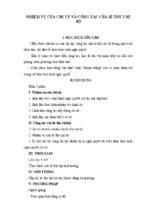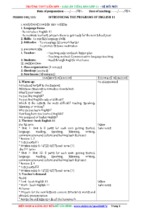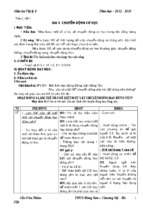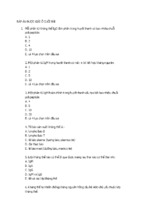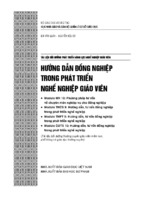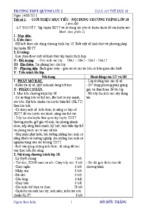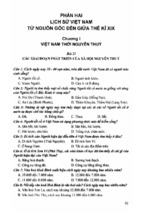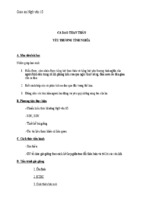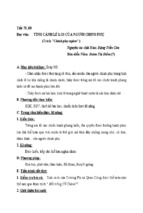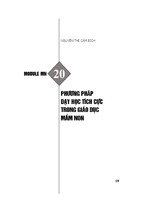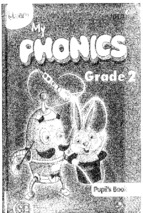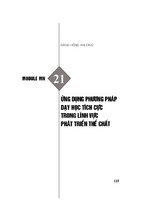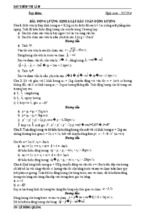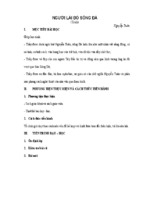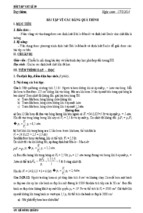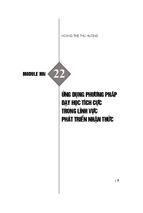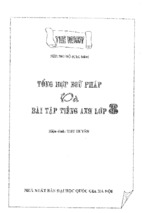1
Date: 20/8/2014
Period: 1
ORIENTATION: GOALS AND PURPOSES
Objectives: By the end of the lesson:
- Students know how to learn English 11, how the book is organized.
- Students know how to do English tests.
Teaching aids: Student’s book, student’s workbook, dictionary, Guideline for teaching English..
Method: Communicative approach.
Procedure:
Teacher’s activities
Students’ activities
I. Stabilization:
- Greeting the class
- Greeting the T
- Checking the students’ attendance
- Answer
II. Check up:
- Ask Ss to answer some questions about their
summer holidays.
III. Warm up:
- Introduce to students about the teacher.
- Ask students about their names and English
knowledge etc.
IV. Guiding:
1. Guiding student’s book and workbook:
* Introduce to students how to use their book and
workbook.
2. Guiding English tests in grade 11:
* Introduce to students about tests.
- Check frequency knowledge for the previous
lesson. (Oral tests)
- Fifteen minutes test (3 times).
- One period test (2 times).
- Semester test (Once for each semester).
* The tests in grade 11 include:
Reading: 25%, Listening: 25%
Writing: 25%, Language focus: 25%
How to do tests: Learn new words frequently, do
exercises in workbook
3. Guiding other books and tape, disc, etc.
- Answer
- Listen to the teacher
- Answer the teacher’s questions
- Put the student’s book and workbook on the
table.
- Listen to the teacher and look through the books.
- Listen to the teacher
- Listen to the teacher and write down the things
which will be prepared at home.
V. Consolidation and Homework:
- Retell what you’ve learnt and what you will
prepare for this semester.
- Ask students to prepare textbook, notebooks and
the things for learning.
- Prepare the next lesson.
---- ----
2
Date:
Period:
ORIENTATION: LANGUAGE LEARNING
Objectives: By the end of the lesson:
- Students know how to learn English skills: Reading, Speaking, Listening, Writing …
- Students know how to practice those skills.
Teaching aids: Student’s book, student’s workbook.
Method: Communicative approach.
Procedure:
Teacher’s activities
Students’ activities
I. Stabilization:
- Greeting the class
- Greeting the T
- Checking the students’ attendance
- Answer
II. Check up:
- No checking
III. Warm up:
- Introduce to students each skill.
- Listen to the teacher
IV. Guiding:
* Introduce to students how to practice reading, - Put the student’s book and workbook on the
speaking, listening, writing, language focus and table.
how to master learning English.
- Listen to the teacher and look through the books.
1/ How to learn READING and vocabulary
- Take note
Read something every day
Practice reading all the passages in the textbook
Children's books, simplified readers (Penguin),
newspapers, magazines, Internet sites, novels …
Read what interests you
Remember that you learn better when you are
having fun.
Read at the appropriate level
You want to learn new vocabulary, but you also
want to understand what you are reading. If you
are looking up every word, the reading is too
difficult.
Review Who, What, Where, When, Why for
each story you read
You can do this for almost any type of reading.
Who is it about? What happened? Why did it
happen? Where did it take place? When did it
take place? This is very useful when you have no
comprehension questions to answer. You can
write or speak your answers.
Record vocabulary in a personal dictionary
o Keep this notebook separate from other work.
o Record vocabulary in alphabetical order. (an
English address book works well because it has
letters of the alphabet)
o Record the part of speech. (sometimes there is
more than one)
o Write a sample sentence for yourself. (don't use
the one from the dictionary)
2/ How to learn SPEAKING and
pronunciation
Talk to yourself
Talk about anything and everything. Do it in the
3
privacy of your own home. If you can't do this at
first, try reading out loud until you feel
comfortable hearing your own voice in English.
Record your own voice
This might feel very uncomfortable, but it will
help you find your weak pronunciation points.
Listen to yourself a few days later. Which sounds
do you have difficulty hearing?
Participate in class
Learn common idioms
Understand the sounds that your language
doesn't have
For example, many languages don't have the "r"
sound. These sounds require extra practice.
Recognize that teachers are trained to
understand you
When you get out into the real world, average
people will have a more difficult time
understanding you unless you practise speaking
slowly and with proper pronunciation.
Practise minimal pairs
Study word and sentence stress
Practice tongue twisters
3/ How to learn LISTENING
Listen to the radio
Don't always have a pen in hand. Sometimes it
helps to just listen.
Watch English TV
Children's programming is very useful for ESL
learners.
Choose programs that you would enjoy in your
own language.
Remember that much of what you hear on TV is
slang.
Watch movies
Use Internet listening resources
4/ How to learn WRITING and spelling
Keep a diary/journal
Don't always pay attention to grammar. Freewriting can be very useful. It can show you that
writing is fun. Have fun with the language.
Write emails in English
Stay in contact with teachers or other students.
Rewrite your local news in English
This is another exercise that can be done on a
daily basis. Remember that regular activities are
the best ones.
Learn important spelling rules
Remember, you won't always have a dictionary or
a spell-checker handy, especially when you are
writing a test. Even native English speakers need
to review the spelling rules from time to time.
5/ Improve Your Grammar
Good grammar prevents ambiguity. By contrast,
bad grammar confuses your reader, slows their
- Listen to the teacher
Practice listening to an English song
- Listen to the teacher
- Listen to the teacher
- Listen to the teacher
4
reading, and shows your ignorance, which can Present some grammar points they’ve learnt from
lose you respect, influence, and credibility.
English 10
Make sure you at least know the parts of speech,
such as nouns, verbs, and adjectives. Find fun
ways to learn the parts of speech.
Know the difference between the active voice
and passive voice. Using the active voice is one of
the best ways to give power to your writing.
Also, learn the basics of punctuation, especially
when to use a comma.
- Take note
V. Consolidation and Homework:
- Retell what you’ve learnt.
- Prepare lesson Reading - Unit 1
---- ----
5
Date: 23/8/2014
Period: 2
UNIT 1: FRIENDSHIP
A. READING
Objectives: By the end of the lesson, Ss will be able to:
- Develop such reading skill as scanning for details, specific ideas, skimming for general information,
and guessing meaning in context.
- Use the information they have learnt to discuss the topic.
Teaching aids: Textbook, handouts, pictures concerning to the topic …
Method: Communicative approach.
Procedure:
Teacher’s activities
Students’ activities
I. Stabilization:
- Greeting the class
- Greeting the T
- Checking the students’ attendance
- Answer
II. Check up:
- No checking
III. Warm up: Network
- T repairs a handout with network of the word “a - Group work
good friend”, sts list some qualities of a good - Discuss about the qualities which friendship
friend
must have to complete the network.
Suggested answers:
Honest, unselfish, constant, loyal, mutual trust,
A good friend
sympathetic, patient …
- T divides the class into 8 groups and gives each
group a handout. T asks Ss to complete the net
work. The winner will be the group completing
the network in the shortest period of time.
IV. Before you read: Discussing the picture and
poem.
- T asks the whole class to look at the picture on
page 12 and asks them some questions:
1. What are girls and boys doing in the picture?
2. How do they feel?
3. What does the picture tell you?
- T ask Ss to work in pairs to read the short poem
on the page13 and answer the question:
{
What do you think of the friend in the
poem?
- T calls on some Ss to answer the questions.
- T may give some comments and the
suggestions.
Pre- teaching vocabulary
- Pair work
Suggested answers:
1. One boy is playing guitar, and the other girls
and boys are singing.
2. They seem very happy because we can see their
smile.
3. The picture tells us that friends can happily do
many things together or friendship is a beautiful
thing that brings happiness to us.
- Suggestion: The friend in the poem is very
dedicated and thoughtful. He/ She is willing to
help his/her friend in any circumstances.
Dedicated /ˈdedɪkeɪtɪd/ (a): tận tâm, tận lực
Thoughtful /ˈθɔːtfl/ (a): chu đáo, quan tâm
Circumstance /ˈsɜːkəmstəns/ (n): hoàn cảnh, tình
huống
6
lasting (a) = lifelong
be concerned with sb/ st
constancy /ˈkɒnstənsi/ (n):
constant (a)
rumour /ˈruːmə(r)/ (n):
gossip /ˈɡɒsɪp/ (n): information talk or stories
about other people’s private lives that may be
unkind or not true
incapable of /ɪnˈkeɪpəbl/ (a):
suspicion /səˈspɪʃn/ (n):
suspicious (a)
pursuit /pəˈsjuːt/ (n)
sympathy /ˈsɪmpəθi/ (n):
sympathetic /ˌsɪmpəˈθetɪk/ (a):
sorrow /ˈsɒrəʊ/ (n) = sadness
- T asks Ss to make some sentences with above
words to check their understanding.
- Some Ss practice reading the vocabulary.
V. While you read:
Setting the scene:
- You are going to read a passage about the
qualities of a long lasting friendship. While you
reading, do the task in the textbook.
Task 1
- T asks the Ss to read the words in the box then
fill each blank with one of them individually.
- Ask Ss to read the passage quickly and stop the
lines that contain these words to guess their
meaning.
- T goes around to help them when necessary.
- T asks Ss for their answers and tells them to
explain their choices.
Task 2
- T asks Ss to read the passage again and decide
which of the choices A, B, C or D most
adequately sum up the ideas of the whole passage.
- T might also want to give Ss some strategies to
find the main idea of the passage.
- T calls on some Ss to give the answer and asks
other Ss to say whether they agree or disagree.
Task 3
- Ask Ss to answers the questions in task 3.
- T asks Ss to do the task individually, then
discuss their answers with their partner.
- T calls some Ss to write their answers on the
board and ask them to explain their choices.
existing or continuing a long while (bền vững,
lâu dài)
quan tâm tới ai, cái gì
tính kiên định
tin đồn
chuyện ngồi lê đôi mach, chuyện tầm phào
không đủ khả năng
sự nghi ngờ
sự nghiệp, sự theo đuổi, đam mê
sự thông cảm
thông cảm, đồng cảm
nỗi buồn
- Do T’s requests
- Whole class
- Individual work & pair work
- Ss guess the meaning of the word base on the
context in the sentences.
Suggested answers:
1. mutual
2. incapable of
3. unselfish
4. acquaintance/friend
5. give - and - take
6. loyal to
7. suspicious
- Whole class read the text carefully
- Individual work
Answer: B
- Individual work and pair work
Correct answers:
1. The first quality for true friendship is
unselfishness. It tells us that a person who is
concerned only with his/her own interest and
feelings can’t be a true friend.
7
VI. After you read:
- Ask Ss to work in pairs to discuss the question
in the text book.
- T goes around to help the Ss when necessary.
- When all pairs have finished, T asks every two
pairs to share ideas.
- T calls on some Ss to report their ideas to the
class.
Extra exercise: Choose the best answer
1. Most of the undeveloped countries need a lot of
____________ aid.
A. together
B. unselfish
C. mutual
D. friend
2. He is too ____________ to lend me his bicycle.
A. selfish
B. enthusiastic
C. helpful
D. pleasant
3. Suddenly she recognized the ____________ of
the situation that made her laugh.
A. pessimist
B. pleasure
C. understanding
D. humour
4. He is a ____________ person because he is
always friendly with everyone.
A. helpful
B. good-natured
C. honest
D. quick-witted
5. If you want to get a good result in every work, you
should have a ____________.
A. loyalty
B. sympathy
C. constancy
D. unselfishness
6. A ____________ friendship is a precious
relationship.
A. mutual
B. sincere
C. generous
D. successful
7. A good marriage is based on ____________.
A. trust
B. loyalty
C. secret
D. A & B
8. The children seem to be totally ____________
of working quietly by themselves.
A. unable
B. impossible
2. Because they take up and interest with
enthusiasm, but they are soon tired of it and they
feel the attraction of some new object.
3. The third quality for true friendship is loyalty.
It tells us that the two friends must be loyal to
each other, and they must know each other so
well that there can be no suspicions between
them.
4. Because if not people can’t feel safe when
telling the other their secret.
5. Because they cannot keep a secret, either of
their own or of others’.
6. The last quality is sympathy. It tells us that to
be a true friend one must sympathize with his/her
friend. Where there is no mutual sympathy
between friends, there is no true friendship.
- Pair work
Suggested answers:
The friendship is very important to our life. A
true friend can helps us when we are sorrow and
when we have difficulty. We can share ideas,
feeling, likes, joys, pleasures, aims … to each
other. Sometimes only true friends can
understand, sympathize us so we feel safe to tell
him/her our secrets. Friendship brings us
happiness. We happily do many things together.
So we can’t live without friendship.
- Take note
- Do exercise
8
C. incapable
D. not able
VII. Consolidation and Homework:
- Summarize the main points of the text.
- Learn by heart all of new words and structures
and give examples.
- Whole class
---- ----
9
Date: 23/8/2014
Period: 3
UNIT 1: FRIENDSHIP
B. SPEAKING
Objectives: By the end of the lesson, Ss will be able to:
- Describe the physical characteristics and personalities of their friends, using appropriate adjectives.
- make a dialogue talking about a famous person
Teaching aids: Textbook, pictures showing friends, etc.
Method: Communicative approach.
Procedure:
I. Stabilization:
- Ss work in groups, take turns to choose the cards
- Greeting the class
then stick them in the right categories.
- Checking the students’ attendance
- Ss can organize the words into four different
II. Check up:
- Call some Sts go to the board and write down categories as follows:
some vocabularies which they learnt in the last
lesson.
III. Warm up: Game “Take them home”
- T divides the class into 4 groups.
- T gives each group a poster and 20 cards then
gives the rule of the game.
Poster:
FACE
NOSE
Cards:
tall
oval
curly
dyed
flat
short
long
HAIR
HEIGH
T
FACE: square, oval, round
HAIR: curly, wavy, dyed, sleek, shoulderlength, long, short, fair, straight, grey
NOSE:
straight, flat, turn up, pointed
HEIGHT: tall, short, medium
Sleek: bong mượt
square
wavy
round
grey
sleek
large
fair
shoulder-length
medium
straight
pointed
broad
turn-up
high
- T asks:
+ Which other words are used for
describing physical characteristics?
IV. Before you speak
Activity 1: Describing people
(Task 1, textbook, p.15)
- Ss’ answers
+ Forehead: broad, high, ...
+ Appearance: handsome, beautiful, goodlooking, well-built, ....
+ Lips: full, thin, ...
- Ss sit in pairs, look at the people and describe
their physical characteristics.
* He/ She is ............. He’s/ She’s got ..............
10
- Introduce “Useful language” to the students:
+ Height: tall, medium, short …
+ Build: slim, thin, well-built …
+ Face: square, large, oval, round, long …
+ Forehead: broad, high …
+ Eye: small, big, black, blue, brown …
+ Nose: straight, crooked, big, small, flat …
+ Chin: pointed chin (cằm nhọn), double chin
(cằm chẻ) …
+ Lips: thin, full, heart-shaped …
+ Skin: white, pale, suntanned, dark, brown,
greasy skin …
+ Hair: Black, grey, red, brown … (shoulderlength straight/curly black)
+ Appearance: handsome, beautiful, good-looking
…
His/ Her hair ..........
* He’s/ She’s ............. with .............. and ........
- T asks students to work in pairs, do Task 1textbook on page 15.
- T asks Ss to listen to their friends’
descriptions and decide who he/ she is.
Activity 2: Vocabulary
- T sets situations and asks Ss to fill in the
blanks.
* He’s always willing to give money to his
friends or help them. He’s a very ..............
man.
*
She never tells lies. She’s a
very ...............person.
* He’s very good at Maths, but he never
talks about that. He’s a .............. person.
* Minh is always cheerful and often tells
jokes, which makes us like to be with him all
the time. He is a very .............. boy.
* .......
V. While you speak
Activity 3: Describing personalities
(Task 2, textbook, p.16)
- T asks Ss to work in groups, do Task 1textbook, page 15.
- Ss do the teacher’s request.
generous
honest
modest
pleasant
Whole class use handouts to describe.
1. The boy is about 16. He is short-sighted
because he’s wearing a pair of glasses. He has
short black hair, a round face with a broad
forehead, a small nose, thin lips and a small chin.
He’s quite good-looking.
2. The girl is about 14. She’s also wearing a pair
of glasses. She has shoulder-length black hair,
and she’s wearing a ribbon (cài tóc). She has an
oval face with a straight nose, full lips and a
pointed chin. She’s quite pretty.
3. The man is in his forties. He’s tall and wellbuilt. He has short brown hair and a square face
with a broad head, small eyes, a crooked nose and
thin lips. He’s quite good-looking.
4. The woman is her twenties. She’s quite tall and
slim. She has long curly brown hair and an oval
11
face with a broad forehead, big eyes, a straight
nose, heart-shaped lips and a small chin. She’s
very beautiful.
VI.After you speak
Activity 4: Role - play:
Talk about a famous friend.
(Task 3, page 16)
- Ss work in groups, discuss and number the
- T helps Ss review some questions about personalities in order of importance in friendship.
physical characteristics, personalities, hobbies, - Each group’s representative will report their
....
results to the class and explain orally why. (Ss’
answers may be different.)
Journalist
Interviewee
Ex: My group thinks that being caring is the most
1/ What’s his/ her His/ her name is __
important in friendship because when friends care
name?
about each other, they will know when to share
2/ How old is he/ she? He/ she is __
happiness or difficulty with their friends
3/ What does he/ she She is __
- Ss make questions, using the suggestions
look like?
(textbook, page 17).
4/ What is he/ she He/ she is __
Model:
like?
5/ What does he/ she He/ she usually __ in A: What is your best friend’s name?
B: Her name’s Lan.
usually do in her / his her free time
A: How old is she?
free time?
B: She is 16 years old.
6/ What are her They are __
A: What does she look like?
hobbies?
B: She is beautiful. She is tall. She has big eyes
7/ What subjects does
She likes __ best
and long black hair.
he/ she like best?
A: What is she like?
8/ How much time
She
spends
about
__
B: She is helpful and studious.
does he/ she spend on
on
__everyday
A: What does she usually do in her free time?
__ everyday?
B: She usually reads books in her free time.
A: What are her hobbies?
B: They are reading and swimming.
A: What subject does she like best?
- T selects some pairs at random and has them B: She likes Maths best.
A: How much time does she spend on Maths
play roles in front of the class.
everyday?
VII: Consolidation and Homework:
- Ask students to write a passage description B: About an hour a day.
about physical characteristics of their best friend. - Ss work in pairs: Journalist & Interviewee.
- Ask students to prepare Part C - Listening
and practice speaking at homework.
12
Date: 27/8/2014
Period: 4
UNIT 1: FRIENDSHIP
C. LISTENING
Objectives: By the end of the lesson, Ss will be able to:
- Develop such listening micro-skills as intensive listening for specific information and taking notes
while listening.
Teaching aids: Textbook, handouts, cassette tapes …
Method: Communicative approach.
Procedure:
Teacher’s activities
Students’ activities
I. Stabilization:
- Greeting the class
- Greeting the T
- Checking the students’ attendance
- Answer
II. Check up:
- Call on some Sts to make pairs: one is a - Do T’s requests
journalist, the other is an interviewee to talk about
a famous friend.
III. Warm up: Matching (Song)
- T divides the class into small groups of 3-4 Sts. - Group work
Then T distributes the following handouts for Suggested answers:
students to match the English words in A with the 1. j
V equivalents in B. Which group finishes first and 2. i
has all the correct answers will be the winner.
3. a
4. c
5. g
A
B
6. h
1. good-natured
a. nhanh trí
7. b
2. friendly
b. hào phóng
8. d
3. quick-witted
c. hiếu khách
9. e
4. hospitable
d. hay giúp đỡ
10. f
5. patient
e. khiêm tốn
6. honest
f. ham học
7. generous
g. kiên nhẫn
8. helpful
h. thật thà
9. modest
i. thân thiện
10. studious
j. tốt bụng
IV. Before you listen:
- Pair work
Talking about your best friend
- T asks Ss to discuss the questions on page 17 in
pairs.
- T calls on some Ss to give their answer and
comments on the answer.
- T gets Ss what they are going to listen about.
Vocabulary pre –teaching
- T helps Ss to pronounce the words given in the - Whole class
book. T may read aloud first or play the tape and
ask Ss to repeat in chorus and individually.
- Eliciting some of these word and those taken
from the listening passage: STRESS
- tòa nhà chung cư
apartment building:
- khiếu hài hước
sense of humour:
- gọi điện cho ai
give sb a ring = phone sb
- vượt qua thời kì khó khăn
go through a rough time:
13
- T may get Ss to make sentences with the words
and give corrective feedback.
V. While you listen: MORE EXERCISE
Task 1
Instruction: You are going to listen to Lan and
Long talk about their best friends. Listen and
decide whether the statements are True or False.
Put a tick () in the appropriate box.
Before Ss listen and do the task, T instructs them
to use some strategies:
+ First, read through the statements to
understand them and underline key words. For
example, the key words in the first statement are:
shared, Nguyen Cong Tru, Residential Area,
Hanoi …
+ Listen to the tape and pay attention to the key
words.
+ Decide whether statements are true or false
based on what they can hear.
- T plays the tape once for Ss to do the task.
- T asks for Ss’ answers and writes them on the
board.
- T plays the tape the second time for Ss to check
their answers.
- T asks Ss to work in group 4 to compare their
answers.
- T checks Ss’ answers by calling some Ss and
asks them to explain their answers.
Task 2: Multiple choice ( worksheet)
- Let Ss listen again and circle the correct
answers.
Worksheet :
1. Ha's family moved to Hai Phong in
a. 1983
b. 1995
c. 1985
2. People think that Hai Phong people are
a. cordial
b. friendly
c.
unfriendly
3. When Lan first went on a trip to Doson,
a. She rode to Ha's house to meet her.
b. She and her family came to Ha's first.
c. Ha rode to Do Son right after Lan gave her
a ring.
4. Long is good at
a. painting
b. singing
c. playing
guitar
5. a. Minh is not only a good listener but also a
helful friend.
b. Minh doesn't really like to listen to Long's
problem but he
always helps Long.
- Pay attention
- Individual work & group work
Suggested answers:
Lan’s talk
1. F (They used to live in the same building there)
2. F ( It is what people think)
3. T
4. F (Lan went to Do Son first and then called Ha,
so Ha rode on her motorbike to Do Son to meet
Lan)
5. T
6. F (They have been best friends since Lan’s trip
to Do Son)
Long’s talk
1. F (They met in college)
2. F (Minh was a guitarist)
3. T
4. T
5. T
- Whole class
- Individual work and then pair work
Keys : 1.c
5.a
2.b
3.c
4.b
14
c. Minh is a good listener, but he doesn't
always help Long.
- Go over the answer with the class.
Task 3
Instruction: You are going to listen to the tape
again and fill the table in the book with notes.
- T plays the tape again for Ss to complete their
notes.
- T gets Ss to work in pair and check their
answers.
- T calls on some Ss to give the answers. T
provides correct answers if necessary. If Ss cannot
complete the task, T might let Ss listen one more
time and pause at the answers for them to catch.
VI. After you listen:
- T asks Ss to work in pairs to talk about how Ha
has been Lan’s best friend and how Minh has
been Long’s best friend.
- T goes around to help and to correct Ss’
mistakes.
- T calls on some pairs to present their answers.
- T elicits feedback from the class and gives final
comments.
VII. Consolidation and Homework:
- Ask students to learn by heart all new words.
- Ask students to prepare Part D - Writing
- Listen to the tape carefully and fill the table in
the book with note.
Suggested answers:
How and where What do they like
did they meet?
about
their
friends?
Lan
- They used to - Ha is very
live in the same friendly
and
apartment
helpful.
building in HN.
- Ha is sociable.
- Lan went on a She’s got many
holiday in Do friends in Do Son
Son and Ha went and
she
there to help her. introduced Lan
around.
Long - They met in - Minh has a
college.
sense of humour.
- Minh played - Minh likes to go
the guitar, and to plays and
Long was a movies.
singer.
- Minh is a good
- They worked listener.
together.
- Minh is friendly
and helpful
- Pair work
- Whole class
Tapescript :
Talk A. Lan
My best friend is Ha . We’ve been friends for a long time . We used to live in Nguyen Cong Tru
Residential Area in Ha Noi . Her family moved to Hai Phong in 1985 . It is said that Hai Phong people
are cold but Ha is really friendly . I first started to get to know her when I was going on a two-day trip to
Do Son last year and I didn’t know anybody there . I gave Ha a ring and she was so friendly, she said,
“Oh, I’ll come to visit you .” So she rode on her motorbike to Do Son and twenty minutes later she was
there . She stayed with me for two days . She happened to know a lot of people there, so she introduced
me around and we’ve been best friends ever since .
Talk B. Long
My best friend is Minh . We met in college . And I was there singing and Minh was a guitarist . So she
worked together a lot, but we also became friends . Minh has a great sense of humor, he’s very funny, and
that’s one of my favourite things about him . And over the years, we have been through good times and
bad times with each other, and that’s one of the things I like best about him . And we have a lot of the
same interests . We like to go plays and movies together . But when we’re going through a rough time,
he’s really a good friend, and he’s a very good listener, and he always helped me through .
15
Date: 30/8/2014
Period: 5
UNIT 1: FRIENDSHIP
D. WRITING
Objectives: By the end of the lesson, Ss will be able to:
- Write about a friend, real or imaginary, using the words and expressions that they have learnt in
previous lesson.
Teaching aids: Textbook, handouts …
Method: Communicative approach.
Procedure:
Teacher’s activities
Students’ activities
I. Stabilization:
- Greeting the class
- Greeting the T
- Checking the students’ attendance
- Answer
II. Check up:
- No checking
- Do T’s requests
III. Warm up: Name Poem
T asks each student to use his/her name to write In pairs and whole class
an acrostic poem. He/she has to use the adjectives
beginning with the letters of the name to describe
Giang is my friend.
Phuong is my friend
his/her friend’s personality or appearance
Generous in giving Perfect
T calls on some ss to write their poems on the
help
Humorous/Helpful
board
Intelligent
Unselfish
Check with the lass
Active in class
Open-hearted
IV. Before you write:
Neat and tidy
Neat
Task 1 :Categorizing
Good-looking
Generous…
- Hang on a chart with descriptive adjectives on
the board :
- Whole class
Tall short dark long round blue fair
smooth
thin high large slim oval
sincere helpful fat thick sociable
caring
straight
medium broad honest
pleasant open-hearted flat handsome beautiful
- Ask Ss to work in groups of 4 to put the
adjectives under the following heading:
Key:
Hair:
Eyes
Build
Hair:
Eyes
Build
Short,
long, Round, blue, Slim, fat
thick
dark, large,
Face
Nose
Complexion
Round, thin,
High, flat,
Fair, smooth
Face
Nose
Complexion
oval
Personality
Forehead
Appearance
Open-hearted, Broad, high
Handsome,
Personality
Forehead
Appearance
sincere,
beautiful
caring,
pleasant,
helpful,
- T sets the scene: You are going to write about a sociable
friend, real or imaginary, using the provided
guidelines.
Task 2: Useful expressions and outline
- Pay attention
-Writing about a friend , real or imaginary, using
the period guidelines .
-Instruct three parts to write and give some
Example: My best friend’s name is Hoa. She has a
suggestions :
round face with a rather flat nose. She has short
* General information about friends: name, age,
hair and a fair complexion. Her eyes are large
sex and home address, when and where you met
16
him/her
*Their physical characteristics and personalities .
* What pupils like about their friend .
Some useful structure
S+ has …. face/ hair…
S to be….
V. While you write:
- T gets Ss to write about their friend in 15
minutes.
- T goes around to observe and to offer help with a
simple outline:
+ His/her name
+ His/ her age
+ When and where you met him or her
+ His/ her physical characteristics
+His/ her personalities
+ Why you like him/ her
VI. After you write:
- T asks Ss to exchange their writing with other Ss
for correction.
- T goes around and collects mistakes and errors.
- T collects some writings for quick feedback.
- T writes Ss’ typical errors on the board and
elicits self and peer correction. T provides
correction only when Ss are not able to correct the
errors. Finally, T provides general comments on
the writings.
and she has a pleasant smile. She is a very
attractive person.
- Individual work
Sample writing:
My best friend’s name is “Sao Mai”, which
means “Morning Star” in English. She is the same
age with me, and we have known each other since
we were in grade 4.
If I was to describe how she looks, I would say
she is very pretty. She is not very tall and quite
slim. She has a round face with long black hair,
big eyes and regular white teeth. That’s why many
people say that her smile can brighten up even the
cloudiest day.
She has a very nice personality and a wonderful
sense of humour. She is also very intelligent and
studious.
The first thing I like about Mai is that she
shares the same interests with me. We both enjoy
listening to music and collecting stamps. In
addition, she is very good at Maths and she helps
me a lot with difficult exercises. However, perhaps
the best thing like about her is her kindness.
Whenever I have a problem, she always
encourages me or gives me helpful advice. I hope
that our friendship will last forever.
VII. Consolidation and Homework:
- Ask Ss to improve their writing, taking into - Pair work and whole class
consideration their best friends’ and T’s
suggestions and corrections.
- Ask them to prepare the next period - Language - Whole class
focus.
---- ----
Date: 30/8/2014
17
Period: 6
UNIT 1: FRIENDSHIP
E. LANGUAGE FOCUS
Objectives: By the end of the lesson, Ss will be able to:
- Distinguish the sound /dʒ/ and /t∫/.
- Pronounce the words and sentences containing these sounds correctly.
- Use some structures containing infinitives with and without to appropriately.
Teaching aids: Textbook, handouts …
Method: Communicative approach.
Procedure:
Teacher’s activities
Students’ activities
I. Stabilization:
- Greeting the class
- Greeting the T
- Checking the students’ attendance
- Answer
II. Check up:
- Check some Sts’ writing.
- Do T’s requests
III. Warm-up:
Chair / traffic jam
- Keep book close
- Ask students to keep book close.
- Listen to the T and complete the sentence:
- Ask students to complete the sentence:
- January is the first month of the year.
a.______ is the first month of the year.
- Children like eating sweets.
b. _______ like eating sweets.
- Ask students to speak the sentence loudly.
With a high level class- book- closed
T divides the class into 2 groups A and B, writes
the phonemic sound/dʒ/ - /t∫/ on the board and
asks ss to write as many words containing these - Listen attentively
sounds as possible, sets the time limited for 1
minute. The group with more correct words wins
the game
- Let students to get their attention on
pronunciation: /dʒ/ - /t∫/.
- Introduce new lesson.
IV. Pronunciation:
- Pronouncing the two sounds separately.
Âm vòm miệng hữu thanh
- T models the two sound /dʒ/ and /t∫/ for few Dây âm thanh rung lên khi phát âm
times and explains the differences in producing
them.
- Listen and take note
/dʒ/: is a voiced palatal
Voiced = vocal cords vibrate while making this
sound.
Âm vòm miệng phụ âm xát
Palatal = put your tongue behind your top teeth, Âm vô thanh: dây thanh âm không rung lên khi
push air as you drop your tongue away from the phát âm
roof of your mouth.
/t∫/ is an unvoiced fricative palatal
Unvoiced - vocal cords do not vibrate while
making this sound.
- Repeat after the tape
Fricative palatal = touch your tongue to the back
of your upper teeth and pull your tongue away as
your push air out of your mouth.
- T plays the tape once for Ss to hear the words - /dʒæm/, /dʒəʊk/, /ˈdʒænjuəri/, /ˈdeɪndʒərəs/, /
containing these two sounds. Then T plays the tape ˈpæsɪndʒə(r)/, /ˈvɪlɪdʒ/
again and this time asks Ss to repeat after the tape. /'t∫ildrən/,
/'t∫eindʒəbl/,
Pronouncing words containing the sounds
/t∫i:z/, /'mju:t∫uəl/, /tʃɜːtʃ/, /wɪtʃ/
- T reads the words in each column all at once
18
/dʒ/: jam, joke, January, dangerous, passenger,
village.
/t∫/: children, changeable, cheese, mutual, church,
which.
- T reads the words once again, each time with a
word in each column to help Ss distinguish the
differences between the sounds in the words.
- T reads the words and asks Ss to repeat them.
- T asks Ss to practice pronouncing the words in
pairs.
- T goes around providing help.
- T asks some Ss to pronounce the words and give
correction if necessary.
Practicing sentences containing the target
sounds
- T reads the sentences and asks Ss underline the
words with the sound and write /dʒ/ and /t∫/ under
them.
- T asks Ss to provide the sentences in pairs.
- T goes around providing help.
- T asks some Ss to read the sentences and gives
feedback.
- Signal: /dʒ/: ge, j
/t∫/: ch, tu
Extra exercise: Pick out the word whose
underlined part is pronounced differently from
that of the other words.
1. A. change B. children C. machine D. church
2. A. guitarist B. passenger C. generous D. village
3. A. mutual B. chip
C. question D. quality
4. A. architect B. arch C. church D. cheese
V. Grammar and Vocabulary:
1. To infinitive
- T writes some sentences on the board and
underline the to + infinitive
+ I have letters to write to my friends.
+ I have some homework to do.
+ Does he get anything to eat?
+ Have you got anything to say?
- T asks Ss to comment on the use of to +
infinitives in these examples. T reviews the form
and use of to – infinities in the example.
- The infinitive can be placed after nouns/pronouns
to show how they can be used or what is to be
done with them.
+ I have letters to write = I have letters that I must
write …
+ I have some homework to do = I have some
homework that I must do.
+ Does he get anything to eat? = Does he get
anything that he can eat?
*To-infinitive: (Agree, allow,arrange, ask,
attempt, care, choose, claim, come, continue,
decide, determine,demand, expect, fail, fear,have,
help, hope, intend, learn, long, manage, mean,
- Practice reading the sentences which contain 2
sounds.
Signal:
The letters such as “Ch, Tu, Tch” contain
the sound /ʧ/ ( question, righteous)
The letters such as “J, G, Dg” contain the
sound /ʤ/ ( soldier, educate)
- Do extra exercise
Suggested answers:
1. C
2. A
3. D
4. A
- In the examples above the infinitives are used
to replace relative clauses
- Take notes
I pleased to see you.
19
plan, pretend, prepare, promise, propose, seem,
tend, want,wish, would like, ….what, how, where
… , refuse, be going, be willing, be able,
permit…..)
- to indicate the purpose or intention of an
action.
Ex : He was doing this to make me more relaxed.
- as the subject of a verb, it is more usual to
begin the sentence with "It".
Ex : To know how to drive is useful. ( It is useful
to know how to drive)
- as an object of a verb.
Ex : She likes to dance
They decided to build a new school.
- after nouns / pronouns as a modifier to replace
a relative clause.
Ex : I have a lot of work to do ( which I have to
do)
- in idiomatic expressions :
Ex : The tea is too hot for me to drink
Jack is clever enough to solve this problem.
- as an adverd to modify an adjective.
Ex : I am sorry to hear the news.
NOTE :
- verb + to- infinitive
- verb + question word + to- infinitive
- verb + object + to- infinitive
-too+adjective/ adverb ( for somebody) + toinfinitive
- adjective / adverb + enough ( for somebody) +
to- infinitive
- enough + noun + to- infinitive
Ex: The water is too hot to drink.
He’s old enough to go to school.
- Individual work
Suggested answers:
1. Who wants something to eat.
2. I have some letters to write.
3. I am delighted to hear the news.
4. My mother has some shopping to do.
5. You always have too much to talk about.
6. It’s lovely to see you again.
7. It’s too cold to go out.
8. I’m happy to know that you have passed the
exams.
Ex: Nothing can make him cry
I see her cook dinner (completed action)
Notice: I see her cooking dinner (I see she’s
cooking dinner)
- Pair work and then individual work
Suggested answers:
1. The police watched them get out of the car.
2. They let him write a letter to his wife.
3. I heard them talk in the next room.
Practice
4. The customs officer made him open the
Exercise 1
briefcase.
- Ask Ss to do exercise 1 individually and then 5. The boy saw the cat jump though the window.
compare their answers with another student.
6. Do you think the company will make him pay
- T calls on some Ss to read aloud their answers.
some extra money?
- T gives the correct answers.
7. I felt the animal move towards me.
8. Do you think her parents will let her go on a
picnic?
- Whole class
Suggested answers:
1. I saw her cross the road.
2. I heard them sing a song.
2. Infinitive without to
3. I observed him lock the door.
- Modal verb: can, will, may, shall, must….
4. I saw her drive off.
- After “make, let”+ object + bare infinitive.
5. He was foolish to leave the firm.
- After verbs of perception such as: feel, hear, 6. I watched a pavement artist draw a portrait in
watch, see, notice, observe, smell + object + bare crayons.
infinitive
7. It would look rude to refuse their invitation.
8. I was happy to meet you again.
- Ask Ss to give some examples.
9. The film was not interesting enough for me to
- Listen and ask the other to comment.
watch.
Practice
10. The woman is too old to drive a car.
20
Exercise 2
- T asks Ss to do exercise 2 in pairs. Ss have to - Listen to the teacher
rewrite the sentences by using the words given.
- T asks them to compare answers with another
pairs.
- T calls on some Ss to go to the board to write
their answers.
- T asks other Ss to feedback and gives correct
answers.
Expected answer:
1. I saw her cross the road.
VI. Free - Practice: Join these pairs of sentences.
2. I heard them sing a song.
1. She crossed the road. I saw her.
3. I observed him lock the door.
2. They sang a song. I heard them.
4. I saw her drive off….
3. He locked the door. I observed him.
4. She drove off. I saw her.
5. He was foolish. He left the firm.
6. A pavement artist drew a portrait in crayons. I
watch him.
7. We can’t refuse their invitation. It would look
rude.
8. I met you again. I was happy.
9. The film was boring. I didn’t watch it.
10. The woman is old. She can’t drive a car.
VII. Consolidation and Homework:
- Learn by heart all the knowledge they’ve learnt
and practice them again at home.
- Prepare the next lesson: Unit 2 - Reading
---- ----
Date: 3/9/2014
- Xem thêm -

